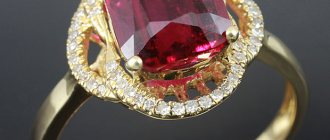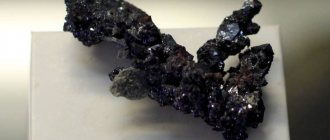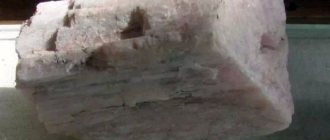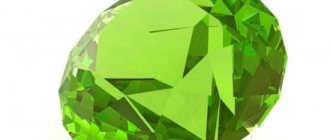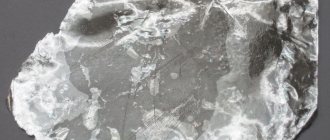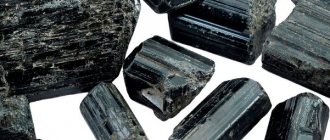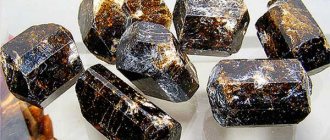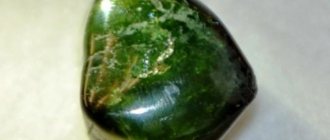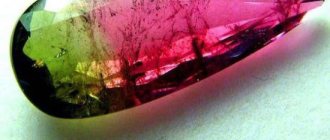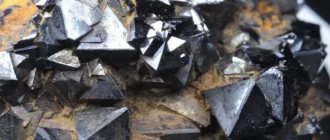rice. Types of tourmaline
Tourmaline is classified as a semi-precious stone and comes in a wide variety of colors.
It is a pyroelectric mineral, meaning that when heated, it attracts dust and other light particles. Gemologists mainly distinguish 4 types of tourmaline:
- Schorl
- Elbaite
- Liddicoatite
- Dravit
rice.
Types of Tourmaline by Color Although Elbait occurs in all color forms, the term in the gem trade is typically used to describe the green form of Tourmaline. Other colored forms of elbaite have their own variety names in the gemstone market. Traditional names for varieties of Tourmaline gemstones include Rubellite, the red or pink variety, Indicolite, the blue variety, and Watermelon Tourmaline, a multi-colored tourmaline in green and red colors.
Tourmaline comes in many colors. Tourmaline colors have many different reasons. Typically, iron-rich tourmalines are black from bluish-black to dark brown, and magnesium-rich varieties are brown to yellow, and lithium-rich tourmalines are almost any color: blue, green, red, yellow, pink, etc. Rarely, it colorless.
rice. Achroite (colorless tourmaline)
Bi-colored and multi-colored crystals are also common, showing variations in chemical composition during the crystallization process. Crystals may be green on one end and pink on the other, or green on the outside and pink on the inside; this type is called watermelon tourmaline.
Some forms of tourmaline are dichroic because they change color when viewed from all angles. All colored tourmalines exhibit pleochroism, which means their color changes when viewed from different angles. In some stones this effect is barely noticeable, while in others it is obvious.
rice. Example of pleochroism in tourmaline
The most expensive and valuable form of tourmaline is the rare "neon" blue form, known under the trade name Paraiba Tourmaline. This type of tourmaline was first discovered in pearl pegmatite in the Brazilian state of Paraiba in 1989.
rice. Paraiba tourmaline
A story about scientists and sailors
Pliny the Elder mentions tourmaline under the name “lychnida”.
Moreover, the scientist distinguishes between varieties of the mineral:
“one that sparkles with purple, the other that is a scale, heated by the sun or the friction of the fingers, they attract chaff and fibers of paper.”
Biruni does not write about tourmaline as an independent mineral.
In an Armenian manuscript from the 18th century. the stone “tirmil” is mentioned - red-green in color.
Red tourmalines in Russia were used to decorate church utensils.
Gems came to Europe from Ceylon. Dutch sailors, who transported cargo from Ceylon to Europe, noticed the beneficial properties of pebbles. They attracted ashes. Those who like to smoke a pipe cleaned their “nose warmers” with the help of gems. And they even gave the stone its name. "Aschentrekker" - " pulling ashes ."
origin of name
Tourmaline - Turmalin - Tourmaline.
From Sinhalese " turmali ". Group name for gems brought from Ceylon (Sri Lanka).
Expert opinion
Semenishcheva Polina
Specialist in mineralogy. Graduated from St. Petersburg Mining University.
Interesting : because of the pyroelectric effect, the crystals were called Ceylon or ash magnets.
- In Germany, Aschenstein (ash stone) and Aschenbrocken (ash crusher).
- In the 18th century green tourmaline, just introduced to Europe, was commonly called Brazilian emerald, and blue tourmaline, Brazilian sapphire.
- “ Ceylon peridot ”, “ Ceylon peridot ” are honey-yellow tourmalines.
Expert opinion
Semenishcheva Polina
Specialist in mineralogy. Graduated from St. Petersburg Mining University.
But all “geographical” names are incorrect and should not be used.
Tourmaline deposits
Tourmaline is widespread and its deposits are found throughout the world. The most famous are located on the islands of Sri Lanka and Madagascar, in countries such as China, Mozambique, Brazil, Burma, Angola, Australia, India, South Africa, Canada, USA, Italy, Switzerland, Tajikistan, Russia (Urals, Transbaikalia, Karelia, Kola Peninsula). Afghanistan is a supplier of high-quality tourmaline samples.
These different, different, different stones
Tourmalines are distinguished by colors:
- Chameleonite. Has an alexandrite effect. It is olive green in daylight and brownish red in artificial light.
- Verdelite. Greens - from light spring greens to dark greens. The color is due to the presence of iron ions. The shades in the crystal change, smoothly shimmering.
- Indigolite. Blue of all shades. The name comes from indigo, a shade of blue. In Russia in the old days it was called baus.
- Dravit. Color ranges from pale cognac to rich brown. Named after the Austrian Dravet deposit.
- Schorl. From the old German miner's term schorl. Black, gloomy, opaque. It is in great demand among magicians and sorcerers.
- Sibirit. Purple-red stone. Found in Siberia, of course.
- Achroite. It got its name from a combination of Greek words; means "without color". Rare colorless variety.
- Liddicoatite. Relatively recently it was recognized as a separate variety of tourmaline. Geometric patterns can be amazingly beautiful.
Polychrome crystals are varied.
Some have a black or red top, called the "Moor's (Turk, Negro) head."
When cut, watermelon tourmaline can resemble a piece of watermelon, with a kelly rind and pink “pulp.” But there are also “stones in reverse” - the middle is green, surrounded by pink.
Watermelon tourmaline 3.6 carats
Properties
Complex boron-containing silicate of magnesium and aluminum.
An oblique view of the whole crystal structure of tourmaline
View of a tourmaline structure unit along the crystal axis
Axis view of three columns of tourmaline units forming a bundle
Structure of a tourmaline crystal as viewed along the c-axis of the crystal
Physico-chemical
- The crystals are hard but brittle.
- Tourmaline that changes color when daylight changes to artificial light is called chameleonite.
- The crystals have a well-defined zonal growth pattern. The color change occurs not only along the main axis of the crystal, but also in the transverse direction.
- Dichroic; This is especially evident in the “head of a Negro (Moor, Turk)” variety.
- It has a piezoelectric effect (when pressed or mechanically applied, an electric charge appears on the surface of the crystal).
- Has pyroelectric properties.
- Mineral crystals are sensitive to temperature increases. If you electrify a crystal, its temperature changes. Tourmaline directly converts thermal energy into electrical energy.
- The red color of the gems is stable when heated.
- Red tourmaline has a strong pleochroism - from dark red to yellow to scarlet.
Tourmaline pleochroism
Some crystals have a sharply defined thin strip of light, if possible oriented along the long axis of the polished stone. This is a cat's eye, highly prized by mineral connoisseurs.
Lithotherapist's book
First, visit a doctor, find out the diagnosis, buy medicine... And only then, if you want, start treatment with stones.
- Lithotherapists in the USA use sherls to get rid of negative energy and relieve pain. To do this, the “pendulum” with the crystal is rotated counterclockwise over the sore spot.
- Verdelite is used in lithotherapy as a strengthening nervous system and rejuvenating agent. Helps with heart and kidney diseases.
- Indigolite harmonizes the hormonal system and stimulates metabolic processes in the body.
- Rubellites normalize blood composition and improve heart function.
- Dravit is used for insomnia, stress, and depression.
Important : thyroid disease, fever (high temperature), pacemakers, pregnancy - the use of tourmaline is not recommended for these conditions.
Colorful magic
Each variety has its own magic.
| Variety | Magic properties |
| Indigolite | Used by magicians and astrologers to connect with the energy of the Cosmos |
| Achroite | Clears the mind, creates a balance of physical and spiritual forces |
| Rubellite | Harmonizes the heart chakra |
| Dravit | Stimulates Manipura Chakra |
| Verdelite | Restores the integrity of the aura. |
| Cherry red tourmaline | Associated with tantric energies |
- Rubellites “manage” love and similar emotions.
- Indigolite is a good talisman for students.
- Verdelites are useful for creative people.
- Achroites are good for yoga fans. These stones are suitable for meditation.
Expert opinion
Semenishcheva Polina
Specialist in mineralogy. Graduated from St. Petersburg Mining University.
Each type of gem will protect the owner from negative energy.
Physico-chemical characteristics of tourmaline
By chemical nature, tourmaline is a complex boron-containing silicate of aluminum, magnesium and iron.
Its composition and appearance are very diverse due to the presence of impurities of potassium, chromium, titanium, vanadium, beryllium, rubidium, cesium, and zinc. Tourmaline crystals are characterized by trigonal structure, lack of cleavage, transparency or opacity, glassy luster, and uneven conchoidal fracture.
Hardness on the Mohs scale 7.5. Specific gravity 3.2 g/cm3. The light refraction is 1.616-1.652.
Areas of application
The unique property of a crystal to carry an electric charge is used in radio engineering.
Tourmalines are very popular among collectors.
The ability of crystals to carry an electrical charge is widely used by Western and Eastern manufacturers. And my God, where they don’t “insert” tourmaline. This:
- belts and bandages (on the knees, on the neck, on the lower back);
- bed sheets;
- socks and underwear;
- massage mats;
- dishes;
- bath balls;
- hair combs.
Jewelry beauty
And here is a little about jewelry art.
At the beginning of the 14th century. Jewelry art is developing in Europe, the masterpiece of which was the “Crown of Charles IV”, converted in 1346 from the crown of St. Wenceslas, the enlightener of the Czech Republic. It is decorated with unique polished stones: pink tourmaline weighing 250 carats; 2 Ceylon sapphires weighing 330 and 280 carats. and 17 sapphire cabochons weighing from 200 carats; 45 red Badakhshan spinels, the largest of which weighs 100 carats; 26 emeralds from Egypt, 20 pearls and an aquamarine.
A huge (over 100 grams in weight) pink tourmaline was purchased in Beijing. Of course, it went to the first lady of Russia, Catherine I. The gem adorned the empress’s crown. When she was replaced on the throne by Anna Ioannovna, the stone from Catherine’s crown was taken out and inserted into the crowns of the new empress. New broom, whatever you want...
The leaders of the Russian Orthodox Church respected the gem. The tabernacle with a large pink crystal (it belonged to the Annunciation Cathedral of the Kremlin) is now kept in the Armory Chamber.
A red stone the size of a pigeon's egg, which King Gustav of Sweden gave to Empress Catherine II in 1777. It was believed to be a ruby. However, research has shown that it is a pink tourmaline weighing 250 carats. Currently located in the Diamond Fund in Moscow.
Who is it suitable for?
- Actors.
- Pupils and students.
- To inventors.
Expert opinion
Semenishcheva Polina
Specialist in mineralogy. Graduated from St. Petersburg Mining University.
Attention : Sherls help you lose excess weight. However, lithotherapists do not recommend wearing them.
Zodiac signs
Tourmaline is suitable for many zodiac signs. The main thing is to choose the right variety.
Sherls are astrologically suitable for Gemini in the second decade.
Green and red gems are suitable for Sagittarius of the second decade.
Watermelon tourmaline is ideal for Aquarius of the 1st decade.
Other representatives of the star circle can wear tourmaline jewelry without harm and be treated with the gem.
Is Tourmaline right for you?
Not really
Element
All elements (Earth, Water, Air, Fire). Depends on the type of gem.
Planets
Pluto
Venus
Energy
Depends on the variety. Either Yang or Yin. In polychromes both types of energies are present.
Schorl
The most popular type of tourmaline is Sherl (about 95% of all tourmaline). Opaque black schorl is an idiochromatic type of tourmaline (it has a high iron and manganese content), unlike other forms, it is not transparent. Externally, it consists of elongated prismatic crystals of a layered structure or short strong prismatic crystals.
Variegated mix
Astrologer Nazarova writes that tourmaline belongs to the group of warrior stones (together with fluorite, pyrite, spinel).
All the beauty of tourmalines is most clearly revealed in daylight. Artificial and evening light extinguishes the beauty and shine of tourmaline.
The most valuable type of mineral is Paraiba Tourmaline.
While searching for mica in the state of Minas Gerais (Brazil), tourmaline deposits were discovered. You don't always find what you're looking for.
The color intensity of tourmalines is valued only up to a certain optimal limit. Above this limit their value decreases.
The famous astrologer T. Macia advises decorating with sherlom rooms where it is necessary to limit excessive frivolity and sensuality.
According to G. Smith, red tourmaline, having been exposed to daylight for about a hundred years, noticeably turns yellow.
The Indians believed that watermelon tourmalines enhance a person's sexual abilities and kindle the passion of love. Therefore, men wore these stones with pleasure. But watermelon tourmaline was prohibited for women. A woman's love will create problems for her man...
How to distinguish natural from artificial
Despite the fairly reasonable price of tourmaline, it is often counterfeited. It’s better to know a few secrets on how to distinguish a quality product from a fake:
- no marks remain on the surface of natural stone if you scratch it with a needle or pin;
- if you look at a crystal through sunlight, you can easily see the effect of pleochroism;
- if you rub a stone with your finger for just a minute, it becomes electrified, this is impossible with a fake;
- you need to bring a thin hair or thread to the electrified stone, a real mineral will easily attract it.
Before purchasing, it is important to understand what tourmaline is and its features, then the purchase will please you and not disappoint you with its false facets.
Questions/Answers
There are quite a lot of tourmalines. This article is a review, “about everyone in general.” But if you have questions, ask them.
How to distinguish a fake?
- Examine the stone with a magnifying glass. A real gem has shimmers and halftones. The fakes don't have this.
- Look for inclusions in the stone? A perfectly clean stone is most likely the work of human hands.
- Natural tourmaline is difficult to scratch. This is not glass.
- Rub the stone with a woolen cloth. Real tourmaline will attract hairs, tiny pieces of paper, and dust.
Please note: “watermelon” tourmalines are often made from cutting crystals of different colors.
In the 1920s, bluish tourmalines from Namibia entered the market. There was demand for green stones. Therefore, Namibian gems were heated, which changed their color to green.
Important : sometimes crystals are refined by annealing or irradiation. Such stones are not considered fake.
How to care?
- Tourmalines are micro-vacuum cleaners. Therefore, store your jewelry in a tightly closed case.
- If a pebble gets dirty, wash it in soapy water and rinse with clean water. Dry with a napkin. Try not to rub the stone. Otherwise, the piezo or pyroelectric effect will work, and your stone will find dust, like an exemplary housewife.
- Gems do not like bright sun - they can fade. But even in the evening, under artificial light, tourmaline loses some of its shine and color.
- Protect your jewelry from aggressive liquids and household chemicals.
How to wear?
- The gem will accept gold and silver equally well. Tourmaline will not accept simple frames (jewelry alloys, copper).
- The stone is rarely set in platinum.
- The magical properties of tourmaline are more pronounced in combination with silver.
- In the old days, tourmalines were recommended to be worn on the index finger of the right hand or on the middle finger of the left hand. Moreover, the frame should be gold or silver.
What is the price?
- A good option is to buy individual cut gems and give them to a jeweler to create a custom piece of jewelry.
- The differences between tourmaline varieties can be significant. Prices per carat of Paraiba start from $4000-6000. Connoisseurs will not be surprised by the price of $20,000 per carat.
- “Simple” tourmalines start at $20 per carat.
- But we must take into account that the price greatly depends on the variety.
- Weight, purity, color, variety affect the final cost of jewelry. And of course, add the cost of the frame here.
What colors are there?
The colors of the stone depend on the presence of iron, chromium, and manganese ions.
Red, green, blue, black, tan and simply colorless.
There are more than fifty shades of tourmaline.
The most valuable ones are pink and red.
In second place are green ones, their color approaches emerald.
Polychrome types are good. One crystal can have up to five colors.
Where can I buy?
Large online stores, jewelry stores, exhibitions and sales of stones. Expensive varieties (for example, Paraiba) should be purchased where they will provide you with proof of the authenticity of the stone.
What stones does it go with?
For the most part, tourmalines are “selfish”. Their energy is self-sufficient; it can hardly tolerate the proximity of other gems.
Tourmaline especially conflicts with rubies, sapphires, and alexandrites.
For your information : P. Globa reports that tourmaline is “not friendly” with garnets.
